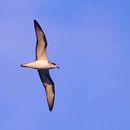Biology
(
Anglèis
)
fornì da Arkive
Barau's petrels are migratory birds, leaving the waters around Réunion between April and June, and heading for the open Indian Ocean, where they spend the winter. Here, they are often seen feeding in large flocks with many other sea birds. They feed on small, schooling fish, seizing them from the surface or plunging into the water to snatch their prey (3). In September, the petrels return to Réunion Island, and in November, females lay a single egg in a nesting burrow high up on the remote mountain cliffs, which hatches between the end of December and the beginning of January (3).
Conservation
(
Anglèis
)
fornì da Arkive
A campaign was implemented to raise public awareness of the effect of urban lighting on petrels, and to rescue as many grounded birds as possible. Each year, many Barau's petrels are now found and rescued, with increasing success; in 2001, 787 petrels were rescued (2) (5). There are also proposals to reduce light pollution on the island (2). Increasing tourism suggests that conservation efforts should include strict regulation of human activities near the colonies, particularly hiking and mountaineering. Efforts should also be made to eradicate potential predators from the nesting colonies (5).
Description
(
Anglèis
)
fornì da Arkive
Discovered as recently as 1963, Barau's petrel remains fairly unknown due to its inaccessible and remote breeding habitat on just a single island in the Indian Ocean (3). Barau's petrel is a medium-sized petrel with greyish-brown plumage on top and white underparts. A fairly distinct 'M' shaped marking extends across the back and wings, and when in flight, the dark edges of the underside of the wing are visible (2). As with other petrels, its large wingspan is an adaptation for continuous flight over the ocean, and its sharp bill with a hooked tip is perfect for dealing with slippery fish prey (4).
Habitat
(
Anglèis
)
fornì da Arkive
The nesting sites of Barau's petrel are in elfin forests on inland mountain cliffs, between 2,000 and 2,800 metres above sea level (3) (5). It appears to require a thick, undisturbed humus layer in which to burrow (5).
Range
(
Anglèis
)
fornì da Arkive
Barau's petrels nest on Réunion Island in the Indian Ocean (3). When not breeding, they occur in the western part of the tropical south Indian Ocean, and have also been sighted in the southern Arabian Sea, between the Maldives and Sumatra, and in the Cocos-Keeling Island region (3).
Status
(
Anglèis
)
fornì da Arkive
Classified as Endangered (EN) on the IUCN Red List 2007 (1).
Threats
(
Anglèis
)
fornì da Arkive
Mammals introduced to the island of Réunion are believed to be impacting the Baraus' petrel; eggs and chicks are preyed on by rats and cats, and goats may trample burrows and disturb suitable nesting habitat (2) (5). However, the extent to which this threatens the species is not clear; the remote, rugged habitat of breeding colonies may have limited access for these alien species (3). In the last 50 or so years, urban development on the island has led to a dramatic increase in the number and intensity of streetlights and other bright lights which confuse large numbers of fledging Barau's petrels on their way to the sea at night. Grounded birds are then usually killed by vehicles or predated by dogs and cats. An additional potential threat comes from the increasing pressure for tourism to remote areas, which could result in human disturbance at the nesting colonies (5).

